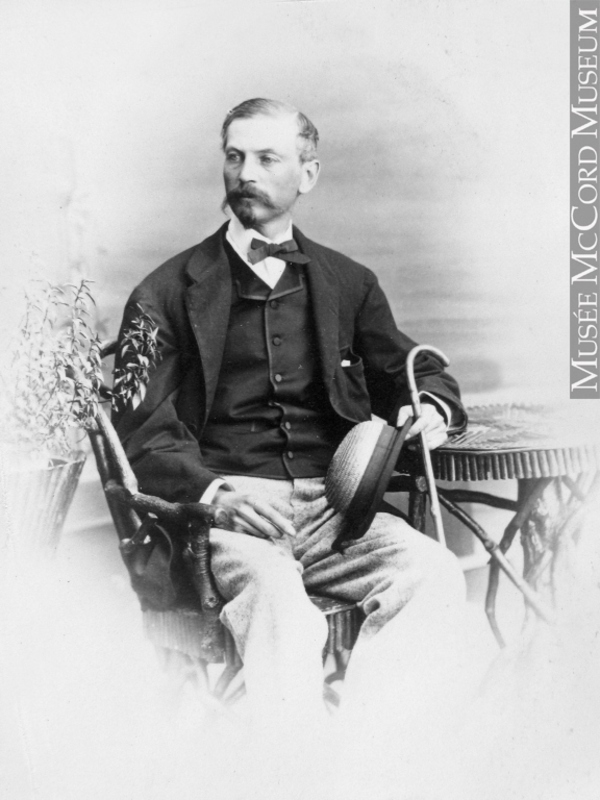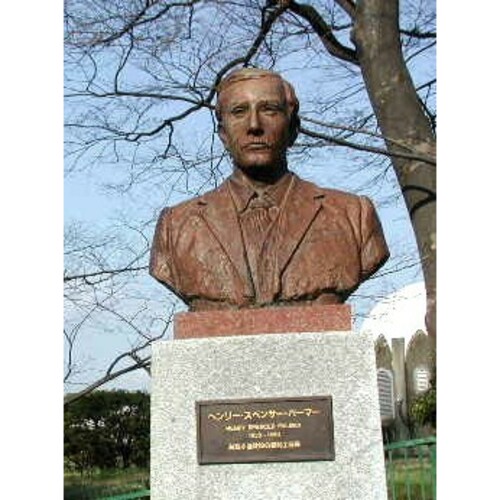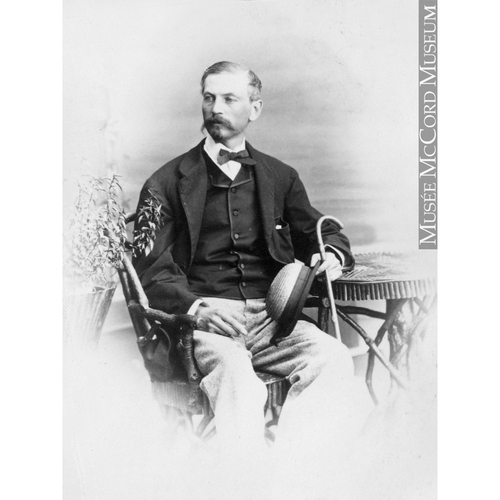
Source: Link
PALMER, HENRY SPENCER, army officer, military engineer, surveyor, and author; b. 30 April 1838 in Bangalore (India), youngest son of John Freke Palmer, colonel in the Madras army, and Jane James, sister of Sir Henry James, re; m. 7 Oct. 1863 at New Westminster, B.C., Mary Jane Pearson Wright, daughter of the Reverend Henry Press Wright, first archdeacon of British Columbia, and they had nine children, three of whom died in childhood; d. 10 Feb. 1893 in Tokyo.
After receiving his early education in England, at schools in Bath and from private tutors, Henry Spencer Palmer was admitted to the practical class of the Royal Military Academy at Woolwich (London) in January 1856. He was gazetted a lieutenant in the Royal Engineers in December and studied for a year at the Royal Engineers Establishment, Chatham. In October 1858 he was appointed to the British Columbia detachment under Colonel Richard Clement Moody*.
Palmer arrived in Victoria the following April and was attached to the survey department under Captain Robert Mann Parsons. In addition to undertaking several exploratory surveys, he laid out trails, supervised road construction, and inspected road-works. One of his first duties was to report on the Harrison-Lillooet trail to the Cariboo gold-fields, and in late 1859 he traversed the region between Fort Hope and Fort Colvile (near Colville, Wash.). His reports on the two expeditions were published in 1860. During the second journey, on 5 October, he encountered Captain John Palliser*, then exploring a route from the southern Prairies to the Pacific coast through British territory. Palmer was able to assure him that the Hudson’s Bay Company trail from Fort Langley to Lake Osoyoos lay north of the 49th parallel.
During the next two years Palmer continued surveying for the Harrison-Lillooet Road, did road work and reconnaissance in the lower Fraser valley, and surveyed part of the Cariboo Road from Yale to Boston Bar. In 1862 he explored a possible alternate route to the Cariboo from North Bentinck Arm to Alexandria by way of the Bella Coola River. Two reports based on the latter expedition were published in 1863 in New Westminster.
Palmer’s accomplishments did not fail to attract the attention of Governor Sir James Douglas* and the Colonial Office. Although the governor was not known to be a friend of the Royal Engineers, he wrote in a dispatch to the colonial secretary, the Duke of Newcastle, on 13 Nov. 1863, “Lieutenant Palmer has been the Subaltern of the Detachment, but upon one or two occasions he has conducted exploring trips through the Colony with great credit to himself and has done good service in fixing points and distances in the Upper Country.” Douglas also forwarded a copy of Palmer’s reports on North Bentinck Arm and the Cariboo to the Colonial Office, whereupon Arthur Johnstone Blackwood, senior clerk for the North American department, commented, “Lt. Palmer is an exceedingly clever young officer, who, being on the spot & faute de mieux, might make a good successor to Colonel Moody, in the Office of Chief Commr. of Lands.” The disbandment of the detachment in July 1863 cut short Palmer’s career in British Columbia. While there, he had taken part in the detachment’s theatricals, served in 1862 on the New Westminster committee for the International Exhibition held in London, and contributed papers on British Columbia to the Royal Geographical Society of London. In November 1863, one month after their marriage, he and his 15-year-old wife sailed for England.
Between 1864 and 1874 Palmer served with the Ordnance survey of Great Britain. He spent most of the two following decades on postings as surveyor, engineer, and astronomer in New Zealand, Barbados, Hong Kong, and Japan, where he settled. After retiring from the Royal Engineers in 1887, he established a successful civil practice in Yokohama. Among his activities were the designs for the harbour works and waterworks for the city – a bust of Palmer was unveiled by the Yokohama Water Works in 1987, its centennial, in the presence of a granddaughter and a great-granddaughter from North America. In the year before his death Palmer and Uta Saito, whom he may have married around 1890, had a daughter. By the time of his death in 1893 he had become well known in Japan and was described by the Japan Weekly Mail as “a man of rare gifts” and “a delightful companion whose memory will long be cherished by a wide circle of friends and admirers.”
[Henry Spencer Palmer’s reports of his British Columbia surveys appear in G.B., Parl., Command papers, 1859 (1st session), 17, no.2476: 15–108, Papers relative to the affairs of British Columbia, part I . . . ; (2nd session), 22, no.2578: 297–408, . . . part II . . . ; 1860, 44, no.2724: 279–396, Further papers relative to the affairs of British Columbia, April 1859 to April 1860 . . ; and 1862, 36, no.2952: 469–562, Further papers . . . February 1860 to November 1861. . . . His accounts of the 1862 expedition were published in 1863 at New Westminster, B.C., as Report on portions of the Williams Lake and Cariboo districts, and on the Fraser River, from Fort Alexander to Fort George and Report of a journey of survey, from Victoria to Fort Alexander, viâ North Bentinck Arm.
Reports by Palmer were also published in the British Columbian between 1861 and 1863, and in the following contributions to the Royal Geographical Soc. of London: “Report on the Harrison and Lillooet Route, from the junction of the Fraser and Harrison rivers to the junction of the Fraser and Kayosch rivers, with notes on the country beyond, as far as Fountain” and “Remarks upon the geography and natural capabilities of British Columbia, and the condition of its principal gold-fields” in its Journal, 31 (1861): 224–36, and 34 (1864): 171–95; and “British Columbia; journeys in the districts bordering on the Fraser, Thompson, and Harrison rivers” and “The geography of British Columbia and the condition of the Cariboo gold district” in its Proc., 4 (1859–60): 33–37, and 8 (1863–64): 87–94.
A collection of Palmer’s letters from Japan to the Times (London) was issued shortly after his death as Letters from the Land of the Rising Sun . . . between the years 1886 and 1892 . . . (Yokohama, 1894); a Japanese translation, Reimeiki no Nihon kara no tegami, prepared and edited by his grandson Jiro Higuchi, appeared there in 1982.
The Yokohama Arch. of Hist. mounted a Palmer exhibition in 1987, based on research by Mr Higuchi, with material drawn from various archives around the world. The fine catalogue issued by the archives, Henry Spencer Palmer – a special exhibition of his work and designs for the water works and harbour works of Yokohama (Yokohama, 1987), is in Japanese and English, and is extensively illustrated. f.m.w.]
PABC, C/AB/30.6, .6J/1; GR 1372, F 1302. PRO, CO 60/1–16; WO 25/3913–15. Japan Weekly Mail (Yokohama), 31 May 1890, 11–18 Feb. 1893. Royal Engineers Journal (Chatham, Eng.), 23 (1893): 110–12. DNB. F. M. Woodward, “The influence of the Royal Engineers on the development of British Columbia,” BC Studies, no.24 (winter 1974–75): 3–51.
Cite This Article
Frances M. Woodward, “PALMER, HENRY SPENCER,” in Dictionary of Canadian Biography, vol. 12, University of Toronto/Université Laval, 2003–, accessed December 22, 2025, https://www.biographi.ca/en/bio/palmer_henry_spencer_12E.html.
The citation above shows the format for footnotes and endnotes according to the Chicago manual of style (16th edition). Information to be used in other citation formats:
| Permalink: | https://www.biographi.ca/en/bio/palmer_henry_spencer_12E.html |
| Author of Article: | Frances M. Woodward |
| Title of Article: | PALMER, HENRY SPENCER |
| Publication Name: | Dictionary of Canadian Biography, vol. 12 |
| Publisher: | University of Toronto/Université Laval |
| Year of publication: | 1990 |
| Year of revision: | 1990 |
| Access Date: | December 22, 2025 |




